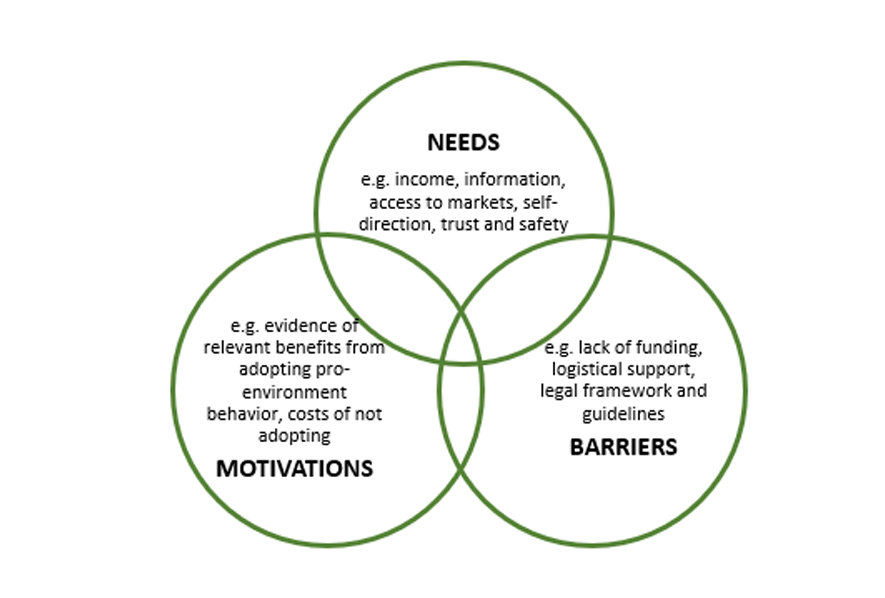How to Get People to Change for the Planet
Installing solar panels, biking to work, switching to sustainable agriculture, buying clothes second-hand instead of new -- what do all these have in common? For one, these are all measures that could help save money and mitigate climate change. These also require individuals and institutions to change their behavior.
Both the Intergovernmental Panel on Climate Change (IPCC) and the Intergovernmental Science-Policy Platform on Biodiversity and Ecosystem Services (IPBES), in their latest flagship reports, recognize behavior change as one of the keys to achieving environmental targets. Behavior change mechanisms, long a research focus in reducing poverty and improving public health, are now increasingly used to design environmental interventions.
Behavior change is likewise getting more attention in the Global Environment Facility (GEF)'s programming directions. We at the GEF Independent Evaluation Office looked at 28 recently completed projects to gain insights on how behavior change takes place in GEF-funded interventions. The most frequently used approach to behavior change was providing information, such as through awareness-raising and training workshops. This reflects the "common sense" thinking that if someone is not doing the right thing, surely it must be because they don't know what the right thing is. Yet we also know from personal experience that we often don't do what we already know we should do. For example, how many of us know we should exercise more and eat better to reap countless health benefits…but don't?
In GEF projects, we found that behavior change approaches were most effective when they addressed the underlying needs, motivations, and barriers of multiple key stakeholder groups. Conversely, project terminal evaluations reported that not addressing these led to less successful or short-lived results.

Needs
Projects that successfully promoted behavior change used a highly participatory, systems-based approach to stakeholder engagement. This approach allowed them to identify and directly respond to stakeholder needs. For example, the project Reducing Deforestation from Commodity Production undertook a needs assessment that covered the range of agricultural situations facing producers in each of the production systems it sought to change in Indonesia and Paraguay. This resulted in demonstration pilots that were well-aligned with meeting the needs that emerged. At project end, it reported an 84 percent average adoption rate of forest-friendly production practices among almost 8,000 beneficiaries, well exceeding its original target in the two countries.
On the other hand, projects that targeted but did not achieve behavior change outcomes relied only on international or regional partners. The lack of country counterparts led to challenges in engaging stakeholders, assessing needs, and gaining trust.
Motivations
Stakeholders were more motivated to change their behavior when they saw the benefits of adopting interventions and/or felt the costs of not doing so. For example, a sustainable land and water management (SLWM) project in Ghana exceeded its target of bringing 15,000 hectares of land under SLWM technologies, after demonstrating an increase in crop yields and income. Implemented in three tranches over a 10-year period, the demonstrations had ample time to show evidence of benefits. At the national level, the government of Ghana was highly motivated to prioritize SLWM initiatives, to avoid the high economic losses that it had already suffered from soil erosion and forest degradation.
Barriers
Our analysis showed that availability of funding, as well as the combination of appropriate laws and logistical support, were most associated with an intervention's likelihood to be sustained. Behavior change was not sustained when projects did not address these financial, logistical and other barriers to adoption in different parts of the system. By first assessing stakeholder needs, successful projects were able to design interventions that removed barriers to adoption. For example, the Southeast Europe and Central Asia Catastrophe Risk Insurance Facility in Kazakhstan aimed to develop an online platform for the public to purchase catastrophic insurance. Beyond just creating a user-friendly interface, it first made sure that the insurance product was both affordable to the public and financially viable for local insurers. Price and high financial risks were key barriers that had led previous insurance initiatives in the country to fail.
Addressing all three together increases the likelihood of behavior change occurring and being sustained, or even scaled up. Find more detailed examples as well as an in-depth discussion of why it's important to track behavior change in Chapter 3 of our Annual Performance Report 2023. You can also read more about the enabling conditions that help sustain behavior change in our evaluation of how impact scales up in the GEF.



